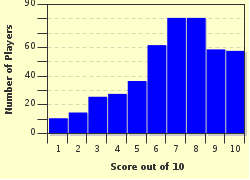Quiz Answer Key and Fun Facts
1. In 9 A.D the Germanic tribal chief Arminius led an army of warriors to victory against the forces of which great power?
2. The Holy Roman Empire was a union of German states that lasted for nearly 1000 years, until it was disbanded in 1806. Which of the below leaders NEVER held the title of Holy Roman Emperor? (Dates below represent years of reign over empire)
3. Martin Luther was the famous German monk whose writing of his 95 Theses, against the Catholic Church, marked the beginning of the Protestant Reformation. In what year did Martin Luther post his 95 Theses on the Castle Church in Wittenberg, Germany?
4. The Thirty Years' War ravaged Germany from 1618 to 1648, and ended with the Treaty of Westphalia. Which of the below statements is NOT true regarding the outcome?
5. In the 18th century, which medium sized German kingdom rose to a leading position in German affairs and became one of the European Great Powers?
6. Often referred to as the Battle of the Nations, this battle in 1813 ultimately ended Napoleon's control over Germany and set the stage for the final campaign against Napoleon in 1814, and again at Waterloo in 1815. What was the other well known name of this battle?
7. As a result of the Franco-Prussian war, the German Empire was proclaimed in 1871. What type of government was the German Empire?
8. Alfred Graf von Schlieffen was the architect of the Schlieffen Plan of World War 1, which involved the German army sweeping through Belgium in the case of war against France. What were von Schlieffen's reported last words about the plan, on his deathbed in 1913?
9. In 1949, the Soviet Zone of occupation became a socialist state. What was the official name of this new country?
10. Who was the Chancellor of the Federal Republic of Germany (A) when construction of the Berlin Wall began, and (B) when the Wall came down?
Source: Author
rwillia1
This quiz was reviewed by FunTrivia editor
bloomsby before going online.
Any errors found in FunTrivia content are routinely corrected through our feedback system.

